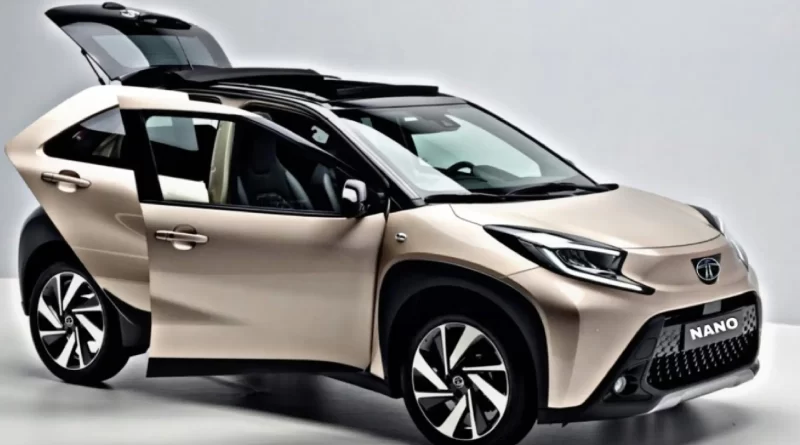Tata Nano Electric Car: A Revolutionary Comeback in the EV Segment
The Tata Nano, once heralded as the world’s most affordable car, is poised for an electrifying comeback with its upcoming electric version. Tata Motors, known for its innovation and commitment to sustainability, is reintroducing the Nano with a modern twist—an all-electric variant that caters to the growing demand for affordable and eco-friendly mobility solutions. The electric Tata Nano is set to reshape the electric vehicle (EV) landscape in India, targeting budget-conscious consumers and urban drivers.
1. The Vision Behind Tata Nano Electric
The original Tata Nano was designed to provide an affordable mobility solution for the masses. While the internal combustion engine (ICE) version of the Nano was revolutionary in terms of pricing, it faced challenges in terms of consumer perception and safety standards. However, Tata Motors has never given up on the idea of delivering affordable mobility, and with the global shift toward electrification, the company is reviving the Nano with an electric powertrain.
The Nano Electric aims to address the need for sustainable and affordable transportation in India, where urban congestion and pollution are significant concerns. By offering an electric version of its iconic Nano, Tata Motors hopes to cater to a wide range of customers looking for budget-friendly electric cars.
2. Expected Launch Date of Tata Nano Electric
As of now, Tata Motors has not officially announced the exact launch date of the Tata Nano Electric. However, industry insiders and reports suggest that the car is expected to make its debut sometime in late 2024 or early 2025. Tata Motors is likely to time the launch to coincide with India’s growing adoption of electric vehicles and increasing infrastructure support for EVs.
The company’s recent success with the Tata Nexon EV, Tigor EV, and the launch of the Tiago EV shows that Tata Motors is rapidly expanding its electric vehicle portfolio. The Nano Electric is expected to be an important addition to Tata’s EV line-up, particularly targeting first-time buyers and city commuters.
3. Key Features of Tata Nano Electric
The Tata Nano Electric is expected to retain the compact design of its predecessor while incorporating modern features to appeal to today’s consumers. Here are some of the expected features:
a. Compact Dimensions with Modern Design
The Nano’s hallmark compactness will be carried forward, making it ideal for navigating narrow city streets and congested urban areas. The electric version, however, will likely get a fresh, modern design with sleeker headlights, LED tail lamps, and possibly some aerodynamic tweaks to improve efficiency.
b. Electric Powertrain and Battery Capacity
While specific details regarding the battery capacity have not been confirmed, it is expected that Tata Nano Electric will come equipped with a lithium-ion battery pack offering a driving range of around 150 to 200 kilometers on a single charge. The electric powertrain will make the car suitable for daily commuting in cities, addressing the range anxiety that many potential EV buyers still face.
c. Quick Charging and Regenerative Braking
The Nano Electric is likely to support fast charging, allowing users to charge the battery up to 80% in less than an hour. Additionally, the car may feature regenerative braking, a system that converts the kinetic energy lost during braking into stored energy for the battery, thereby extending the driving range.
d. Infotainment and Connectivity
To appeal to tech-savvy consumers, the Tata Nano Electric will likely feature a touchscreen infotainment system, which may support Apple CarPlay and Android Auto. The car could also come equipped with Bluetooth connectivity, USB ports, and a digital instrument cluster for a modern, user-friendly experience.
e. Safety Features
One of the main concerns about the original Nano was its lack of advanced safety features. Tata Motors is expected to address this by equipping the Nano Electric with essential safety features like dual airbags, ABS with EBD, rear parking sensors, and a strong body frame. These enhancements will align the car with modern safety standards.
f. Environmentally Friendly Design
As an EV, the Tata Nano Electric will produce zero tailpipe emissions, contributing to reduced air pollution in urban areas. This aligns with India’s goal to reduce its carbon footprint and promote cleaner transportation options.
4. Mileage and Performance
The concept of “mileage” in electric cars is often referred to as the range—the distance the car can travel on a single charge. The Tata Nano Electric is expected to offer a range of 150 to 200 kilometers per charge, making it an excellent choice for daily city commutes.
In terms of performance, the electric motor is likely to provide decent acceleration and torque, making the Nano Electric zippy and nimble in city traffic. Electric cars generally deliver instant torque, which means drivers can expect responsive performance at lower speeds. While it may not compete with larger electric cars in terms of raw power, the Nano Electric will excel in efficiency and ease of use.
Tata Curve EV, Petrol, and Diesel – Full Review, Features, Mileage, and Price Breakdown
5. Affordability: The Key to Success
Tata Motors has always positioned the Nano as an affordable car, and the electric version is expected to continue that legacy. Although the exact pricing has not been revealed, industry experts predict that the Tata Nano Electric will be priced around ₹4 to ₹6 lakhs, making it one of the most affordable electric cars in the Indian market.
This competitive pricing will be a game-changer for electric vehicles in India, as most existing EVs are still priced beyond the reach of many consumers. By offering a low-cost, electric alternative, Tata Motors could attract a large number of budget-conscious buyers, especially those looking for a second vehicle or a primary car for urban use.
6. Charging Infrastructure and Tata’s EV Ecosystem
One of the challenges facing electric vehicles in India is the lack of adequate charging infrastructure. However, Tata Motors is working closely with Tata Power to set up a network of EV charging stations across the country. The Nano Electric will benefit from this growing infrastructure, allowing users to access public fast chargers in major cities.
Additionally, Tata Motors has introduced home charging solutions for its EV customers, ensuring that users can easily charge their vehicles overnight without relying solely on public charging stations. This holistic approach to the EV ecosystem will make owning and operating the Tata Nano Electric even more convenient for consumers.
7. Competitors and Market Positioning
The Tata Nano Electric will enter a market that is gradually becoming more competitive. While there are few electric cars in the sub-₹10 lakh range, the Nano Electric will face competition from Maruti Suzuki’s upcoming EVs, MG Comet EV, and other small electric cars expected to launch in the next few years.
However, Tata Motors has a distinct advantage with its established position in the electric vehicle segment, thanks to the success of the Nexon EV and Tigor EV. The company’s experience in EV development, combined with the affordable pricing of the Nano Electric, will give it a strong market position.
8. Sustainability and the Future of Affordable EVs in India
The launch of the Tata Nano Electric reflects a broader trend in India’s automotive industry, where manufacturers are shifting focus toward greener and more sustainable vehicles. With the government’s emphasis on promoting electric mobility through subsidies, tax incentives, and the FAME (Faster Adoption and Manufacturing of Hybrid and Electric Vehicles) scheme, the Nano Electric is set to benefit from these policy measures.
As India gears up to transition to electric vehicles, the Tata Nano Electric will play a crucial role in democratizing EV ownership and making sustainable mobility accessible to a larger population. Its compact size, affordability, and eco-friendliness make it an ideal option for urban commuters, and its success could inspire other automakers to focus on developing affordable EVs for the masses.
Conclusion: The Future is Electric for Tata Nano
The Tata Nano Electric is more than just the revival of a beloved car; it represents a significant step forward in India’s electric vehicle revolution. With its expected affordable pricing, practical range, and eco-friendly design, the Nano Electric could be the answer to the growing demand for affordable electric cars in India.
As the country continues to embrace electric mobility, the Tata Nano Electric is well-positioned to become a game-changer, making sustainable transportation accessible to the masses and driving India’s transition to a greener future.
Top 3 Electric Cars in India 2024: Range, Charging & Features




